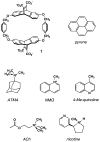The cation-π interaction
- PMID: 23214924
- PMCID: PMC3957424
- DOI: 10.1021/ar300265y
The cation-π interaction
Abstract
The chemistry community now recognizes the cation-π interaction as a major force for molecular recognition, joining the hydrophobic effect, the hydrogen bond, and the ion pair in determining macromolecular structure and drug-receptor interactions. This Account provides the author's perspective on the intellectual origins and fundamental nature of the cation-π interaction. Early studies on cyclophanes established that water-soluble, cationic molecules would forego aqueous solvation to enter a hydrophobic cavity if that cavity was lined with π systems. Important gas phase studies established the fundamental nature of the cation-π interaction. The strength of the cation-π interaction (Li(+) binds to benzene with 38 kcal/mol of binding energy; NH4(+) with 19 kcal/mol) distinguishes it from the weaker polar-π interactions observed in the benzene dimer or water-benzene complexes. In addition to the substantial intrinsic strength of the cation-π interaction in gas phase studies, the cation-π interaction remains energetically significant in aqueous media and under biological conditions. Many studies have shown that cation-π interactions can enhance binding energies by 2-5 kcal/mol, making them competitive with hydrogen bonds and ion pairs in drug-receptor and protein-protein interactions. As with other noncovalent interactions involving aromatic systems, the cation-π interaction includes a substantial electrostatic component. The six (four) C(δ-)-H(δ+) bond dipoles of a molecule like benzene (ethylene) combine to produce a region of negative electrostatic potential on the face of the π system. Simple electrostatics facilitate a natural attraction of cations to the surface. The trend for (gas phase) binding energies is Li(+) > Na(+) > K(+) > Rb(+): as the ion gets larger the charge is dispersed over a larger sphere and binding interactions weaken, a classical electrostatic effect. On other hand, polarizability does not define these interactions. Cyclohexane is more polarizable than benzene but a decidedly poorer cation binder. Many studies have documented cation-π interactions in protein structures, where lysine or arginine side chains interact with phenylalanine, tyrosine, or tryptophan. In addition, countless studies have established the importance of the cation-π interaction in a range of biological processes. Our work has focused on molecular neurobiology, and we have shown that neurotransmitters generally use a cation-π interaction to bind to their receptors. We have also shown that many drug-receptor interactions involve cation-π interactions. A cation-π interaction plays a critical role in the binding of nicotine to ACh receptors in the brain, an especially significant case. Other researchers have established important cation-π interactions in the recognition of the "histone code," in terpene biosynthesis, in chemical catalysis, and in many other systems.
Figures
References
-
- Sunner J, Nishizawa K, Kebarle P. Ion-solvent molecule interactions in the gas phase. The potassium ion and benzene. J Phys Chem. 1981;85:1814–1820.
-
- Cabarcos OM, Weinheimer CJ, Lisy JM. Competitive solvation of k+ by benzene and water: Cation-pi interactions and pi-hydrogen bonds. J Chem Phys. 1998;108:5151–5154.
-
- Cabarcos OM, Weinheimer CJ, Lisy JM. Size selectivity by cation-pi interactions: Solvation of k+ and na+ by benzene and water. J Chem Phys. 1999;110:8429–8435.
-
- Ma JC, Dougherty DA. The cation-π interaction. Chem Rev. 1997;97:1303–1324. - PubMed
-
- Amicangelo JC, Armentrout PB. Absolute binding energies of alkali-metal cation complexes with benzene determined by threshold collision-induced dissociation experiments and ab initio theory. The journal of physical chemistry A. 2000;104:11420–11432.
Publication types
MeSH terms
Substances
Grants and funding
LinkOut - more resources
Full Text Sources
Other Literature Sources
Research Materials
Miscellaneous




